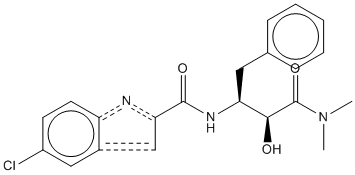All AbMole products are for research use only, cannot be used for human consumption.

CP-91149 is a human liver glycogen phosphorylase α (HLGPα) inhibitor with an IC50 of 0.13 μM in the presence of 7.5 mM glucose. CP-91149 suppressed glucagon-triggered glycogenolysis in isolated rat hepatocytes and in primary human hepatocytes. In vivo, oral injection of CP-91149 to diabetic ob/ob mice at 25–50 mg/kg led in rapid (3 h) glucose lowering by 100–120 mg/dl without producing hypoglycemia. In addition, upon treatment with CP-91149, A549 non-small cell lung carcinoma (NSCLC) cells accumulated glycogen with associated growth retardation. Treated normal skin fibroblasts also accumulated glycogen with G1-cell cycle arrest that was associated with inhibition of cyclin E-CDK2 activity. Overall, cells expressing high levels of brain GP were growth prevented by CP-91149 associating with glycogen accumulation whereas cells expressing low levels of brain GP were not affected by the agent.
| Cell Experiment | |
|---|---|
| Cell lines | HSF55 and T98G |
| Preparation method | Exposing cells to various concentrations of CP-91149 for 72hours. Determining viability with manual cell counts following staining with trypan blue exclusion assay. Fixing cells with 70% ethanol. Staining DNA with propidium iodide and the intensity of fluorescence is measured using a Becton-Dickinson flow cytometer at 488nm for excitation and at 650nm for emission. Using Modifit's Sync Wizard is analyze the cell cycle profile . |
| Concentrations | Dissolved in DMSO, final concentrations ~50 μM |
| Incubation time | 72 hours |
| Animal Experiment | |
|---|---|
| Animal models | Obese, diabetic male C57BL/6J-Lep(ob/ob) mice and their lean, nondiabetic C57BL/6J-/+ littermates |
| Formulation | Formulated in vehicle consisting of either 0.25% (wt/vol) methyl cellulose in water or 0.1% Pluronic P105 Block Copolymer Surfactant in 0.1% saline |
| Dosages | ~50 mg/kg |
| Administration | Orally |
| Molecular Weight | 399.87 |
| Formula | C21H22ClN3O3 |
| CAS Number | 186392-40-5 |
| Solubility (25°C) | DMSO 70 mg/mL |
| Storage |
Powder -20°C 3 years ; 4°C 2 years In solvent -80°C 6 months ; -20°C 1 month |
| Related Products |
|---|
| Diethylenetriaminepentaacetic dianhydride
Diethylenetriaminepentaacetic dianhydride (DTPA anhydride) is a bifunctional chelator whose anhydride can react with amino groups in proteins (such as lysine residues) to form stable amide bonds. Diethylenetriaminepentaacetic dianhydride (DTPA anhydride) can also bind to radionuclides to synthesize radionuclide-labeled drug conjugates (RDCs). |
| 3-Phenylthiophene
3-Phenylthiophene is a biochemical material that can be used in scientific research. 3-Phenylthiophene is a conducting polymer precursor. |
| DSPE-PEG-FA
DSPE-PEG2K-FA is a PEG derivative containing folic acid. DSPE-PEG2K-FA has a targeting effect and can bind to folic acid receptors in cancer cells. DSPE-PEG2K-FA forms micelles/lipid bilayers and can be used in research on targeted drug delivery systems. |
| Lifastuzumab
Lifastuzumab is a humanized anti-NaPi2b IgG1 monoclonal antibody. |
| GPVI antagonist 1
GPVI antagonist 1 is a glycoprotein VI (GPVI) platelet receptor antagonist. GPVI antagonist 1 inhibits collagen-induced platelet aggregation with an IC50 of 25.3 μM. |
All AbMole products are for research use only, cannot be used for human consumption or veterinary use. We do not provide products or services to individuals. Please comply with the intended use and do not use AbMole products for any other purpose.


Products are for research use only. Not for human use. We do not sell to patients.
© Copyright 2010-2024 AbMole BioScience. All Rights Reserved.
